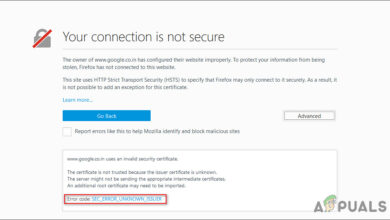Corrupted Content Error ‘mail.google.com’
This ‘Corrupted Content Error‘ typically appears when Firefox users attempt to access the web version of Gmail. The issue is confirmed to occur with multiple Gmail domains including .com, .uk., and .ru.

Most commonly, this issue occurs due to a partially glitched service worker service. If that’s the case, the fix is very easy – simply unregister it from your Firefox browser and you’re ready to go. Other potential culprits are corrupted Gmail cookie/cache or a Firefox glitch that was resolved with the latest builds.
However, most recently, this problem might surface due to a recent Mozilla policy change that makes Firefox distrust Public networks. In this case, you can resolve the issue by switching your Network Profile to Public.
How to Fix the Corrupted Content Error when accessing Gmail?
1. Unregister the Gmail Service worker
One of the most common fixes for this issue is to access the Service Workers window in Firefox and unregister the entry associated with Gmail.
A service worker is a script that runs in the browser background, separate for a web page. This allows for features that don’t require a web page or user interaction. In most cases, service workers facilitate push notifications and background sync. As you can imagine, Gmail has a service worker for both these features.
As it turns out, several affected users have managed to fix the ‘Corrupted Content Error‘ issue in Gmail by accessing the Service Workers window in Firefox and unregistering the entry associated with Gmail.
Update: According to various affected users, this is not a persistent workaround, as the issue has the potential of returning after some time.
After doing this and registering it again, most affected users have confirmed that the issue was resolved.
Here’s a quick guide on doing this from your Firefox browser:
- Ensure that you have a reliable connection to the Internet.
- Open your Firefox browser and paste the following command into the navigation bar and press Enter to land directly into the Service Workers page:
about:serviceworkers

Accessing the Service Workers page - Once you arrive at the correct Page simply find the entry associated with your Gmail and click on the Unregister button.
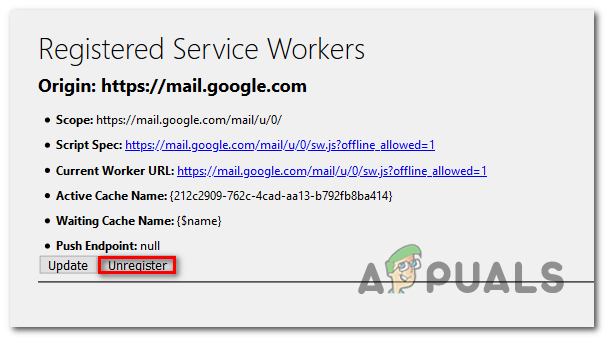
Registering the service worker associated with Service Workers - Once the service worker has been removed, restart your browser and attempt to reconnect with Gmail once again.
In case the same ‘Corrupted Content Error‘ is still occurring, move down to the next potential fix below.
2. Reload page without cache
If the first method has worked but you’re looking for an even quicker approach, you can achieve the same end results by forcing the Gmail page to load without any cached data. But keep in mind that just as the first method, this is not a persistent workaround – Chances are the issue will reappear the next time you open Gmail normally.
To force the Gmail page to load without, simply visit the page that is failing with the ‘Corrupted Content Error‘ issue and press Ctrl + F5 or Ctrl + Shift + R.
After you do this, the page should reload normally without any issues.
In case the shortcut above was successful, here’s a quick guide on permanently cleaning the cache of your Firefox browser:
- Ensure that every other Firefox tab (except the one you’re actively using) is closed.
- Click on the action button in the top-right corner of the screen, then click on Options from the context menu that just appeared.
- Once you’re inside the settings menu, select the Privacy & Security tab from the left-hand table. Next, scroll down to the Cookies and Site Data menu and click on Clear Data.
- To start the process, click Clear to begin the process of cleaning your browser of cached web content data.
- Restart your browser and see if the issue is resolved.

Cleaning the web cache of Firefox
In case you’re still encountering the same error or you’re looking for a long-lasting fix, move down to the next method below.
3. Update Firefox to the latest version
As it turns out, this particular issue can also occur due to Mozilla Firefox bug that was reported to occur on Windows 10 and Windows 8.1 builds. Fortunately, Mozilla is already aware of this problem and has already released a hotfix for the issue.
To take advantage of this hotfix, you will need to update Firefox to the latest version available. Several affected users that forced their browser to update have reported that the issue was finally resolved the next time they restarted their browser.
Here’s a quick guide on updating Firefox to the latest version:
- Open Mozilla Firefox and click on the action button in the top-right corner. Next, select on the Help submenu, then click on About Firefox.
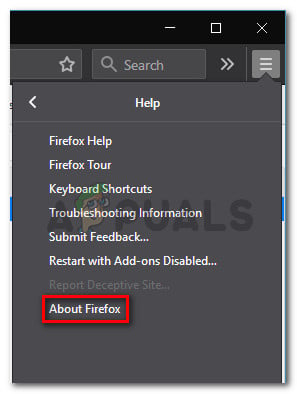
Accessing the Help menu of Firefox - Once you’re inside the About Mozilla Firefox menu, click on Restart to update Firefox, then wait for the process to complete. When you see the UAC (User Account Control) prompt associated with the Firefox updater, click Yes to grant admin access.
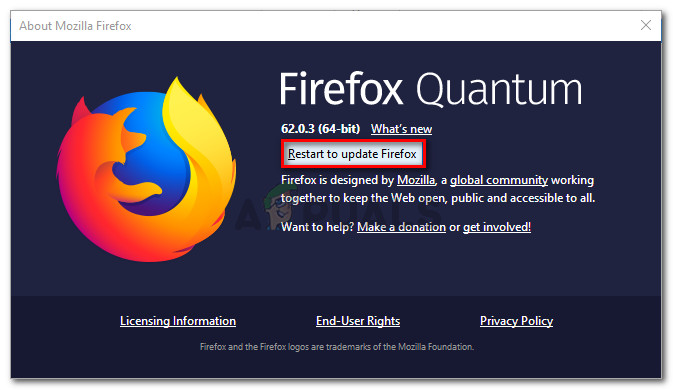
Updating Firefox to the latest version - Once your Firefox is restarted, attempt to access Gmail again and see if the ‘Corrupted Content Error‘ issue is still occurring.
If the problem is still happening, move down to the next potential fix below.
4. Delete Stored Data for Gmail
As it turns out, you might also be able to resolve the issue by browsing to the location of the stored data folder of Gmail manually and deleting its content.
Several affected users have confirmed that this operation is what finally allowed them to view their Gmail Inbox in Firefox without encountering the ‘Corrupted Content Error‘ issue. As opposed to the majority of fixes featured so far, this is frequently reported as being a permanent fix since it gets rid of the data that might be causing the problem.
Here’s a quick guide deleting the stored data folder for Gmail using File Explorer:
- Ensure that Firefox and any other associated instance (like an add-on, or browser security program) is completely closed.
- Press Windows key + R to open up a Run dialog box. Next, type ‘%userprofile%\AppData\Roaming\Mozilla\Firefox\Profiles\‘ and press Enter to open up the profiles folder of Mozilla Firefox.

Accessing the Profile folder of Firefox via Run command - Once you’re inside the Profiles folders, double-click on the folder that ends with .default (not default-release).

Accessing the correct Firefox profile - After you manage to get inside the correct profile, simply right-click on the folder associated with Gmail and choose Delete from the context menu.
- As soon as you delete the folder, fire up your browser and see if the problem is resolved at the next system startup.
In case you’re still encountering the ‘Corrupted Content Error‘ issue, move down to the next method below.
5. Change the Network Profile
As it turns out, Mozilla Firefox tends to prevent users from accessing Gmail and other web services that use service workers in instances where the network service is set to Public. This is part of a recent policy change that Mozilla enforced at the end of 2019.
Fortunately, if this scenario is applicable, you can fix the issue easily by by changing your Network profile from Public to Private. This procedure has been confirmed to be effective by several different affected users.
Here’s a quick guide on changing the Network Profile to Private:
Note: The steps below can be followed regardless of the Windows version that you’re using.
- Press Windows key + R to open up a Run dialog box. Inside the text box, type ‘ms-settings:network-ethernet if you’re using a cabled connection or ‘ms-settings:network-wifi‘ if you’re connected via a Wi-Fi Connection.
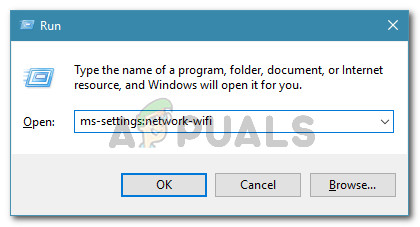
Running dialog: ms-settings:network-wifi - Once you’re inside the network menu, click on your active internet connection. Next, from the next window, select the toggle associated with Private. If you’re prompted by the UAC (User Account Prompt), click Yes to grant administrative privileges.

Turning your network profile into Private - Restart your machine and see if the issue is resolved at the next system startup.




